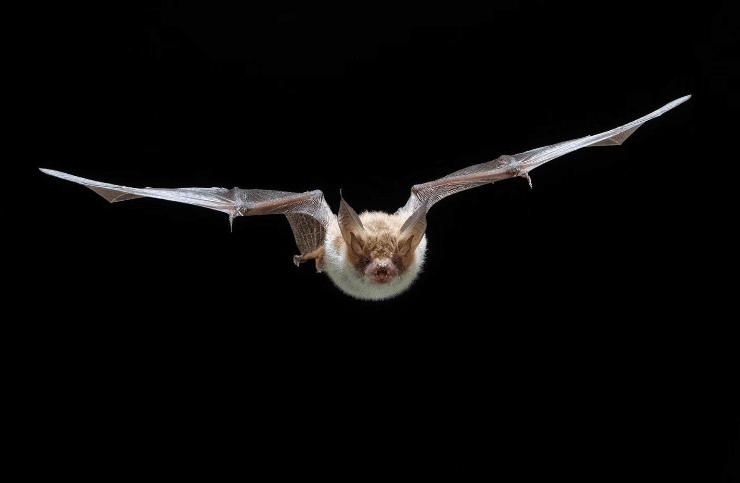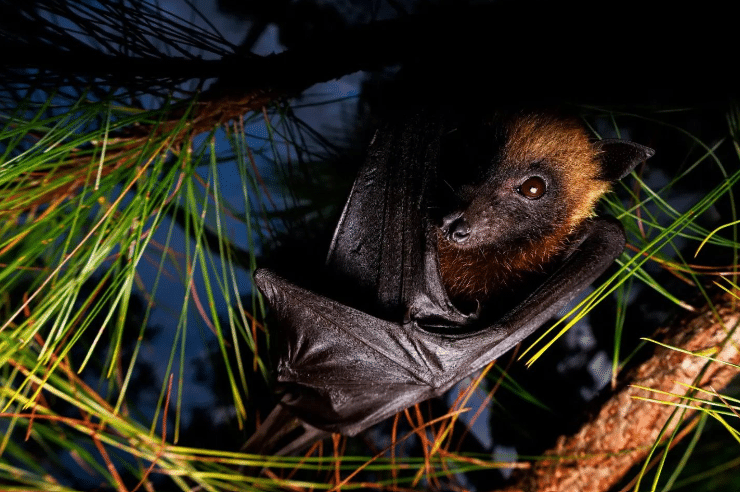You’ve probably seen them flitting about at dusk, perhaps even admired their aerobatics as they swoop and dart through the night sky. Bats are fascinating creatures that have developed remarkable adaptations to thrive in their nocturnal world. From the smallest Pipistrelle to the larger Noctule, these flying mammals are a key part of our ecosystem.
You might wonder how they navigate so effortlessly in the dark or how they’re able to find and catch their insect prey with such precision. The secret lies in echolocation – a complex biological sonar system that bats use for orientation and hunting. In this article, we’ll delve into the intriguing world of bats, exploring everything from their anatomy and species diversity to their unique echolocation ability and exceptional hunting techniques.
Overview of British Bat Species
You’d be amazed to know that there are 18 different species of bats native to Britain, each with their unique echolocation techniques and hunting strategies. These bat species range from the common pipistrelle which you’re likely to spot in your garden, to the rare Bechstein’s bat that prefers mature woodlands. Bat migration is a fascinating aspect of these creatures’ lives. Some species like the Nathusius pipistrelle undertake significant journeys across Europe while others, such as the brown long-eared bat tend not to stray far from home.
As for their diet, most bats feed on insects – making them an essential part of our ecosystem by controlling pest populations. The greater horseshoe bat, for instance, has a penchant for beetles and moths whereas Daubenton’s bats skim close to water surfaces snapping up aquatic insects with their large feet. Each species’ diet influences its hunting technique and echolocation frequency; it’s truly astonishing how they’ve adapted over time to thrive in different habitats and food sources.

Bat Anatomy
You’ll find it fascinating to discover how every aspect of a bat’s body contributes to its survival in the night sky.
Adaptations for Nocturnal Life
In the stillness of night, you’re likely to find bats dominating the sky with their adept adaptations for nocturnal life. These small, winged creatures are well-equipped for life in darkness, thanks to their impressive night vision adaptations. Unlike humans who struggle to see in low light conditions, bats have evolved to thrive when dusk falls. Their eyes possess a high concentration of rod cells – photoreceptor cells that are incredibly sensitive to light and motion. This allows them to navigate swiftly through dense forests or skim flawlessly over bodies of water even on the darkest nights.
But it’s not just their superior night vision that sets them apart; let’s talk about dietary preferences too. Bats in Britain primarily feed on insects – a perfect meal that comes alive at night. They’ve developed an acute sense of hearing known as echolocation which enables them to locate these tiny morsels mid-flight with pinpoint accuracy; it’s like having your own built-in radar system. This combination of special adaptations gives the bat an edge over other animals in the competition for nocturnal food resources and reveals why they’re such successful predators under the moonlit skies.
Features for Flight and Echolocation
Featuring wings that are actually modified arms and hands, bats are exceptional fliers, effortlessly performing acrobatics in the air that would make even the most seasoned gymnast green with envy. This unique adaptation allows them to dominate the night sky, deftly avoiding obstacles and hunting their prey. One of their incredible abilities is echolocation – they emit high-frequency sounds that bounce off objects in their environment, effectively creating a ‘sound map’ of their surroundings. This makes them masters at manoeuvring through pitch-black nights and dense forests.
Understanding Echolocation
You’ve undoubtedly heard of echolocation, but do you truly grasp how it works? It’s a fascinating system used by bats to navigate their world and locate food. By understanding the role of echolocation, you’ll gain a new appreciation for these mysterious creatures and their incredible abilities.
How Echolocation Works
Like a superhero with radar-like powers, a bat uses echolocation to navigate the dark skies and hunt down its prey. You might have some misconceptions about echolocation, associating it with the deafening sonic boom generation of supersonic jets. However, it’s not quite like that for bats. Echolocation in bats is a finely tuned sensory system that allows them to perceive their surroundings by listening to echoes from their ultrasonic calls. So instead of causing booming noises, they produce high-frequency sounds beyond human hearing capacity.
Now let’s delve into how exactly this fascinating process works. When hunting, bats send out a series of rapid-fire sound waves by opening and closing their mouths or nostrils. These sound waves travel until they hit an object and bounce back to the bat. The returning echoes provide detailed information about the object’s distance, size, shape, and even texture – all crucial when you’re on the prowl for your next meal under cover of darkness. Just think about navigating your way around in pitch black – tricky, right? But with echolocation on their side, these night fliers make it look easy.
The Role of Echolocation
In the realm of night-time navigation, it’s echolocation that plays a starring role, transforming bats into masters of their darkened domain. Contrary to popular belief, bats aren’t blind. They have perfect vision for daylight hours and when darkness falls, they switch to their secret weapon – echolocation. This technique allows them to navigate with precision and hunt efficiently in complete darkness. However, there are some misconceptions about echolocation. It’s not like sonar used by submarines or dolphins; rather than creating an exact picture of their surroundings, bats interpret echoes from their high-frequency calls to understand where objects are in space.
Echolocation is more than just a navigation tool; it’s also crucial for bat communication. Bats can alter the frequency and duration of their calls depending on the situation. For instance, while hunting they produce rapid series of short clicks that increase as they home in on prey – a behaviour known as ‘feeding buzz’. Bats also use different call patterns to communicate with each other within their colony or during mating rituals. So next time you’re out at dusk and hear the faint echo of bat chittering above your head, remember: it’s not just noise but a complex form of language all its own.

Echolocation in Different Species
Each species of bats has its own unique style of echolocation, and that’s what makes their nightly hunts so fascinating. The evolution of echolocation in these creatures is a testament to their ability to adapt to different environments and hunting situations. For instance, the Common Pipistrelle emits high frequency calls that are well suited for detecting small insects close by. On the other hand, the Greater Horseshoe bat uses lower frequency calls enabling it to detect larger prey at greater distances. It’s remarkable how each bat species has fine-tuned this skill over time as part of their survival mechanism.
Beyond hunting, echolocation also plays an important role in bat communication. Bats often live in large colonies where effective communication is key. By emitting specific frequencies and interpreting the returning echoes, they can not only locate a tasty meal but also navigate complex roosting spaces and avoid collisions with fellow bats. You’ll find that some species even have social calls, separate from their echolocation pulses, used specifically for interacting with each other.
Hunting Techniques of Bats
Bats have developed a range of hunting techniques that are truly impressive. You see, during bat migration – when they travel vast distances in search for food and favourable conditions – they must adapt their hunting style based on prey availability. It’s not simply about catching any insect in mid-air; there’s an element of prey selection involved. Bats tend to choose insects that provide the most energy return for the least effort expended.
And it doesn’t stop there. Some species employ a technique known as ‘gleaning’ where they essentially pluck insects off surfaces such as leaves or bark without them even knowing what hit them. Others use a ‘flycatching’ strategy where they capture prey mid-flight using echolocation to accurately track and pinpoint their targets. These adaptations ensure that no matter what type of insect is available, these clever critters will have a way to catch it – all so they can fuel those long migrations and thrive in their nocturnal world.
Conclusion
Understanding bat anatomy and their adaptations provides us with a glimpse into the fascinating world of these mysterious creatures. Their ability to navigate and thrive in darkness showcases the wonders of nature’s ingenuity and highlights the importance of preserving these remarkable creatures and their unique role in our ecosystem. As we continue to learn more about bats, we deepen our appreciation for their contribution to the delicate balance of nature and their place in the night sky.
Sam loves to learn about animals and their habitats. He has been a nature lover from a very young age, and has been writing papers and articles about wildlife for as long as he can remember.
